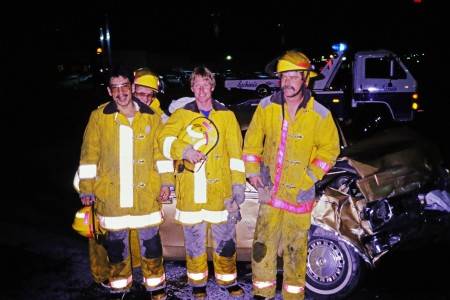TACHYCARDIA / NARROW
ALL LEVELS
DESIGNATION OF CONDITION
Heart rate over 150 bpm with supraventricular focus. Patients with narrow complex tachycardia are often familiar with their problem and symptoms. Asymptomatic patients (unusual) may be comfortable with SVT and treatment is up to the discretion of the paramedic. Patients presenting with hemodynamic instability, evidence of poor perfusion, chest pain, AMS, SOB, cyanosis or evidence of CHF are considered unstable and invasive intervention should be implemented per this protocol.
EMPHASIS ON PATIENT CARE
Maintain adequate perfusion, adequate oxygenation, and ALS intervention
1. Primary Management - Assess ABC’s and manage as indicated.
2. Perform the modified Valsalva maneuver
a. Have patient blow into 10 ml syringe for 15 seconds attempting to move plunger while sitting up, after 15 seconds have patient stop blowing and place patient supine and elevate legs to 45 degrees for 15 seconds.
3. Initiate transport to appropriate medical facility. Consider ALS intercept.
4. Secondary Management - History, physical exam, vital signs
a. If suspected AMI, administer ASPIRIN [325 mg] PO. Chewed then swallowed
AEMT
5. In-route, initiate IV/IO of an isotonic solution, titrate to maintain end organ perfusion.
PARAMEDIC
6. If patient is hemodynamically unstable, provide the following care:
a. Trendelenberg position and fluid bolus.
b. Administer ADENOSINE 12 mg. rapid IV (see note below for humeral site) Draw Adenosine into 20 ml. syringe. Fill with NS. Bolus IV rapidly. Pediatric dose at the end of protocol.
c. If rhythm remains after 1-2 minutes repeat adenosine 12 mg IVP times 2.
d. IO is not recommended Route for Adenosine Administration unless humeral placement
7. If patient’s condition deteriorates with hemodynamic instability, perform synchronized cardioversion immediately. If the patient is conscious, consider sedation using:
a. MIDAZOLAM [2-4 mg] IV/IO/IN/IM, prior to cardioversion, if appropriate to patient condition.
b. Cardiovert at 50-100 joules. If unsuccessful escalate joules:
i. Maximum energy is 200 joules. Any cardioversion is uncomfortable and higher joules can be painful.
8. If patient’s cardiac rhythm changes treat per applicable guidelines.
9. Consider and treat potential underlying causes, e.g., hypoxemia, dehydration, fever.
10. Signs and Symptoms of Hemodynamic instability:
Hypotension
Acutely Altered Mental Status
Signs of Shock
Signs of Acute heart Failure Ischemic Chest Pain
13. If ventricular rate is >150/min, prepare for immediate cardioversion. May give brief trial of medications based on specific arrhythmias. Immediate cardioversion is not indicated if heart rate is <150.
14. Adenosine should be administered rapidly though a proximal (e.g. antecubital) vein site. May be give IO from humeral IO site.
15. PEDIATRIC DOSE OF ADENOSINE
1. 0.2 mg/kg up to a maximum dose of 12 mg. May repeat times two if needed.
2. CHART OF NORMAL HEART RATES IN CHILDREN
Age Heart Rate
0-3 mo 80-205
4 mo – 2 yr 75-190
2-10 yr 60-140
>10 yr 50-100
ALL LEVELS
DESIGNATION OF CONDITION
Heart rate over 150 bpm with supraventricular focus. Patients with narrow complex tachycardia are often familiar with their problem and symptoms. Asymptomatic patients (unusual) may be comfortable with SVT and treatment is up to the discretion of the paramedic. Patients presenting with hemodynamic instability, evidence of poor perfusion, chest pain, AMS, SOB, cyanosis or evidence of CHF are considered unstable and invasive intervention should be implemented per this protocol.
EMPHASIS ON PATIENT CARE
Maintain adequate perfusion, adequate oxygenation, and ALS intervention
1. Primary Management - Assess ABC’s and manage as indicated.
2. Perform the modified Valsalva maneuver
a. Have patient blow into 10 ml syringe for 15 seconds attempting to move plunger while sitting up, after 15 seconds have patient stop blowing and place patient supine and elevate legs to 45 degrees for 15 seconds.
3. Initiate transport to appropriate medical facility. Consider ALS intercept.
4. Secondary Management - History, physical exam, vital signs
a. If suspected AMI, administer ASPIRIN [325 mg] PO. Chewed then swallowed
AEMT
5. In-route, initiate IV/IO of an isotonic solution, titrate to maintain end organ perfusion.
PARAMEDIC
6. If patient is hemodynamically unstable, provide the following care:
a. Trendelenberg position and fluid bolus.
b. Administer ADENOSINE 12 mg. rapid IV (see note below for humeral site) Draw Adenosine into 20 ml. syringe. Fill with NS. Bolus IV rapidly. Pediatric dose at the end of protocol.
c. If rhythm remains after 1-2 minutes repeat adenosine 12 mg IVP times 2.
d. IO is not recommended Route for Adenosine Administration unless humeral placement
7. If patient’s condition deteriorates with hemodynamic instability, perform synchronized cardioversion immediately. If the patient is conscious, consider sedation using:
a. MIDAZOLAM [2-4 mg] IV/IO/IN/IM, prior to cardioversion, if appropriate to patient condition.
b. Cardiovert at 50-100 joules. If unsuccessful escalate joules:
i. Maximum energy is 200 joules. Any cardioversion is uncomfortable and higher joules can be painful.
8. If patient’s cardiac rhythm changes treat per applicable guidelines.
9. Consider and treat potential underlying causes, e.g., hypoxemia, dehydration, fever.
10. Signs and Symptoms of Hemodynamic instability:
Hypotension
Acutely Altered Mental Status
Signs of Shock
Signs of Acute heart Failure Ischemic Chest Pain
13. If ventricular rate is >150/min, prepare for immediate cardioversion. May give brief trial of medications based on specific arrhythmias. Immediate cardioversion is not indicated if heart rate is <150.
14. Adenosine should be administered rapidly though a proximal (e.g. antecubital) vein site. May be give IO from humeral IO site.
15. PEDIATRIC DOSE OF ADENOSINE
1. 0.2 mg/kg up to a maximum dose of 12 mg. May repeat times two if needed.
2. CHART OF NORMAL HEART RATES IN CHILDREN
Age Heart Rate
0-3 mo 80-205
4 mo – 2 yr 75-190
2-10 yr 60-140
>10 yr 50-100
